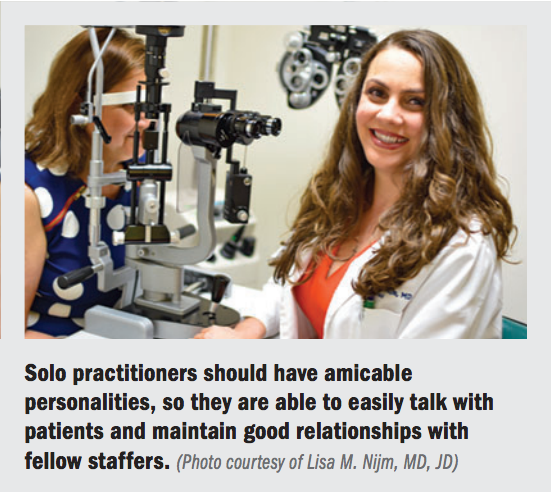Article
Flying solo poses challenges, flexibility and support vital
Author(s):
Operating a small practice may require physicians to wear many hats

Ophthalmologists operating a small practice are looking for better patient relationships and independence.
Reviewed by Lisa M. Nijm, MD, JD
Running a solo or small practice today can be a challenge, and the question is whether it is sustainable. Judging from comments by experts, the short-term answer might be “no.” But not so fast, according to Lisa M. Nijm, MD, JD, who five years ago founded her own solo practice, Warrenville EyeCare and Lasik, Warrenville, IL.
She is also associate professor of ophthalmology, University of Illinois Eye and Ear Infirmary. For one thing, young ophthalmologists deciding on their career direction have a distinct advantage over colleagues in most other specialties.
“We are one of the few specialties in medicine that has the luxury of not being connected to a hospital in most cases, and therefore we have more ability to pursue a solo practice,” Dr. Nijm said. “If you want to build your own business and you have the drive and entrepreneurial spirit to hang you own shingle, you can do it. Studies show a decreased rate of burnout and greater physician satisfaction in solo or small group practices.”
Dr. Nijm suggests that the first step when considering a solo practice is to do some serious soul searching. Physicians should consider what they are looking for in a practice day-to-day and whether this ideal is more likely to be found in an academic or private practice, a solo or group setting.
“The more that you self-reflect and develop a clearer picture of what you’re looking for, the better prepared you will be to evaluate if your expectations match those of the practice settings that you’re considering,” she said.
Dr. Nijm followed this advice when deciding to open her practice after having worked in both a small, ophthalmology-only group and a large multispecialty clinic. She was motivated by her desire to develop deeper relationships with her patients and maintain autonomy and independence while having the flexibility to adopt new technologies when she felt that it would best serve her patients.
RELATED: Sound fiscal knowledge vital to harmony, practice successShe outlined her formula for success in solo practice. “Imagine yourself like Han Solo in the Star Wars movies,” she said. Similar to the personality and actions this character displayed in the original trilogy, she recommends:
- Being friendly, adaptable, and action-oriented
- Planning ahead
- Building a squad or team with shared goals
- Recognizing challenges
- Using various resources available to you to help establish your practice
Dr. Nijm suggested that a solo practitioner would ideally have an amicable personality, which would allow them to easily talk with patients and maintain good relationships with staff members.
Other desirable traits would include the ability to adjust to new technology and regulatory requirements. As a business owner, they must possess the willingness to take action when problems arise. Physicians who fit this description also must focus on the concept of planning ahead.
“It takes a lot longer than you may anticipate setting up a solo practice,” Dr. Nijm said.
Before seeing the first patient, physicians need to create a business plan, understand the community they are working in, and be realistic about how long it will take to be accepted on insurance panels and obtain hospital credentials.
Often, there is a lag time between opening a practice and receiving steady reimbursements. Therefore, a major consideration is obtaining the necessary funding ahead of time to purchase equipment, hire staff, and float a functioning practice for anywhere from three to six months.
‘Strike back’ against challenges
Then, just as the cinematic “rogue hero” Han Solo was constantly doing battle with Darth Vader and other villains, solo practitioners will confront their own particular challenges: insurance companies and Medicare, billing and coding-not something physicians should simply leave to their staff, Dr. Nijm emphasized-as well as government compliance requirements and human resources.
Again, like Han Solo, who had help from an assortment of partners as he crisscrossed a galaxy far, far away, solo physicians are leaders who must build a strong and compassionate supporting team, united around a core theme.
“You want to send a message from the beginning that you put the patient first,” Dr. Nijm said. “When you put the patient first, everything else falls into place.”
Resources such as the IRIS registry (Intelligent Research in Sight) can be extremely helpful to solo practitioners, she added, and advised doctors just starting out on their own to spend time interacting with other physicians in the community, which can result not only in a useful business network but lasting friendships.
“I’m confident that if you follow these steps with the goal of providing the best care for our patients, the next big thing will be the return of the solo practice,” Dr. Nijm concluded.
Disclosures:
Lisa M. Nijm, MD, JD
P: 630/393-7100; E: nijm77@aol.com
This article was adapted from Dr. Nijm’s presentation at the 2018 meeting of the American Academy of Ophthalmology. Dr. Nijm did not report any relevant financial relationships.
Newsletter
Don’t miss out—get Ophthalmology Times updates on the latest clinical advancements and expert interviews, straight to your inbox.




